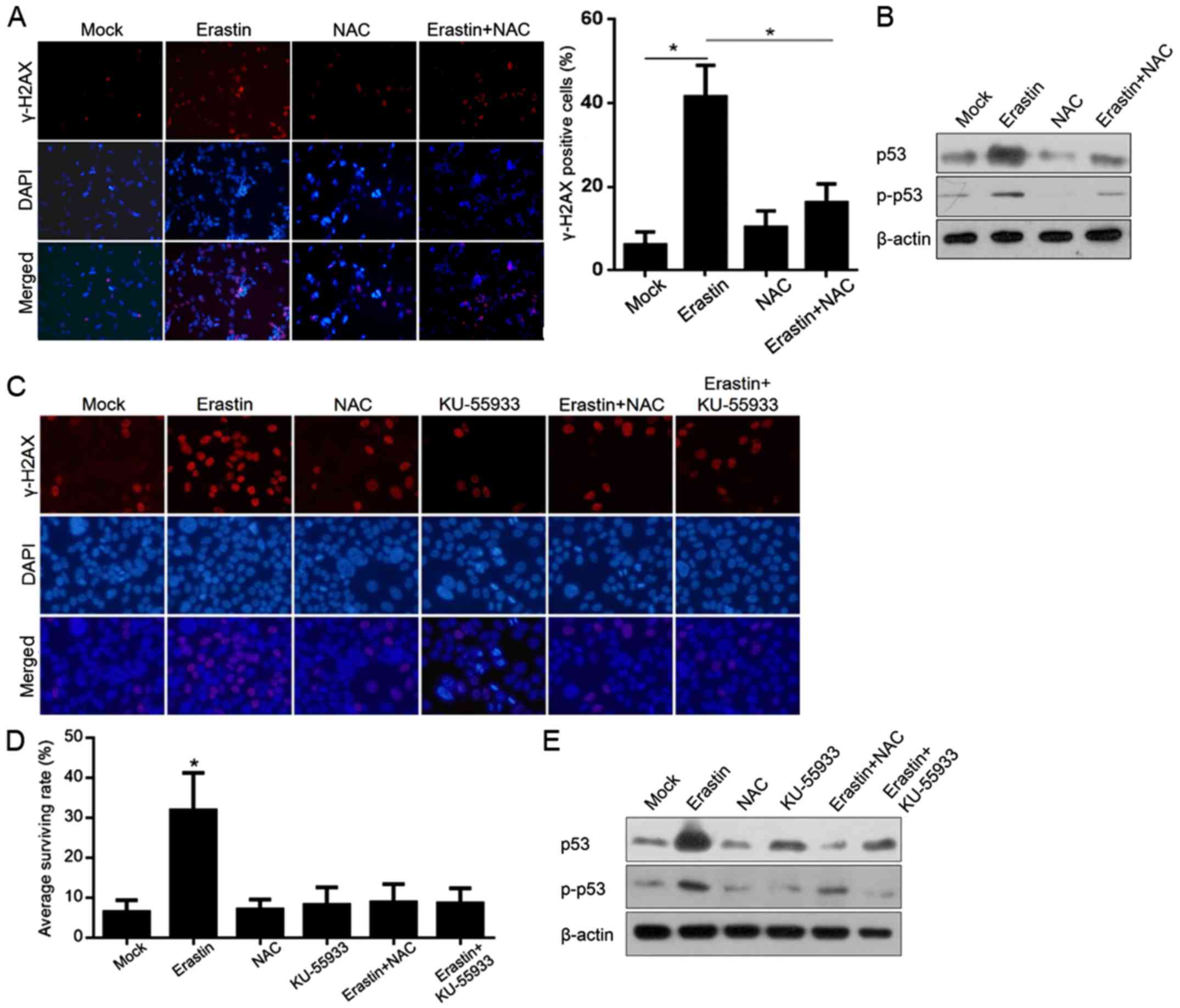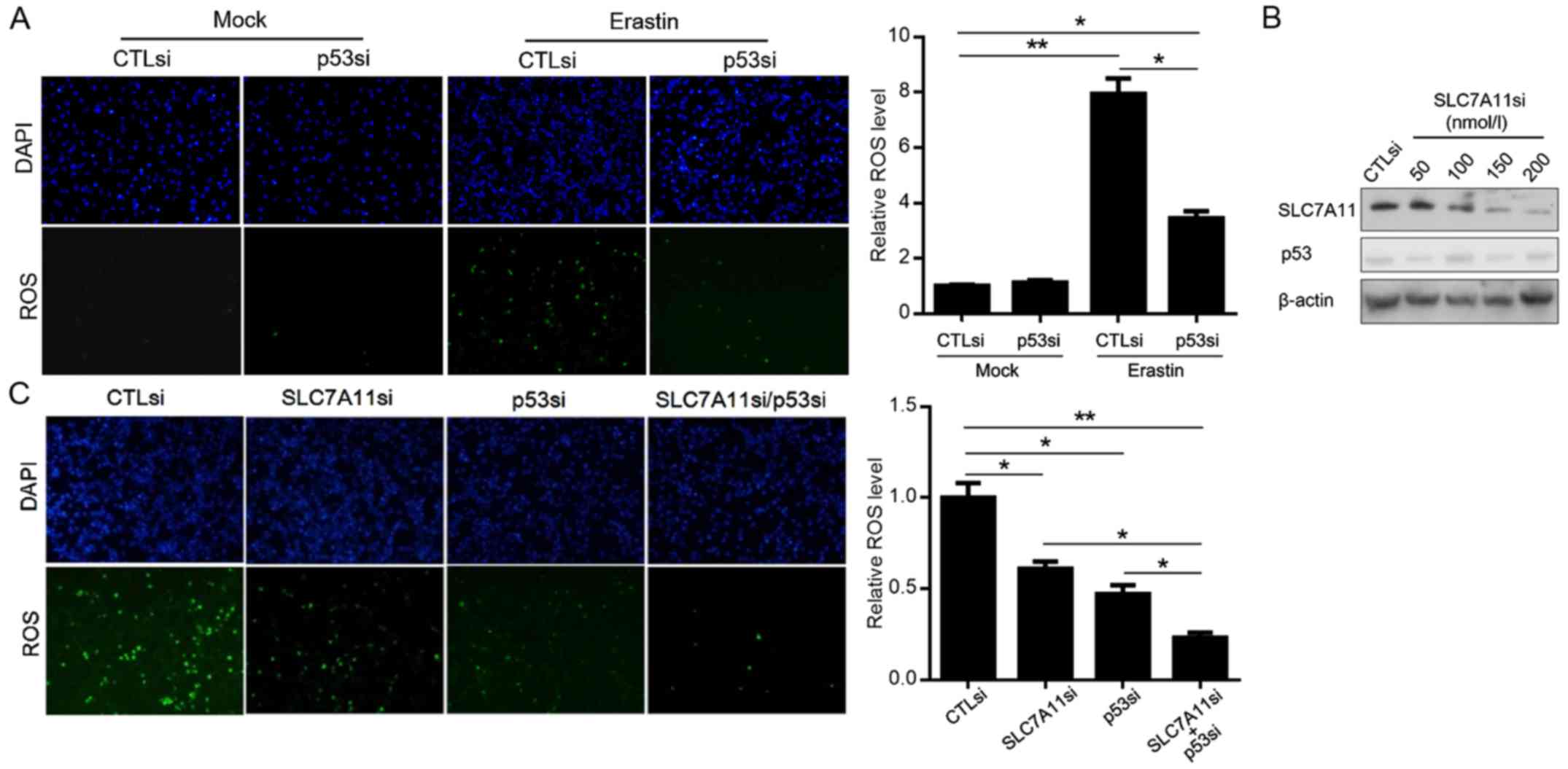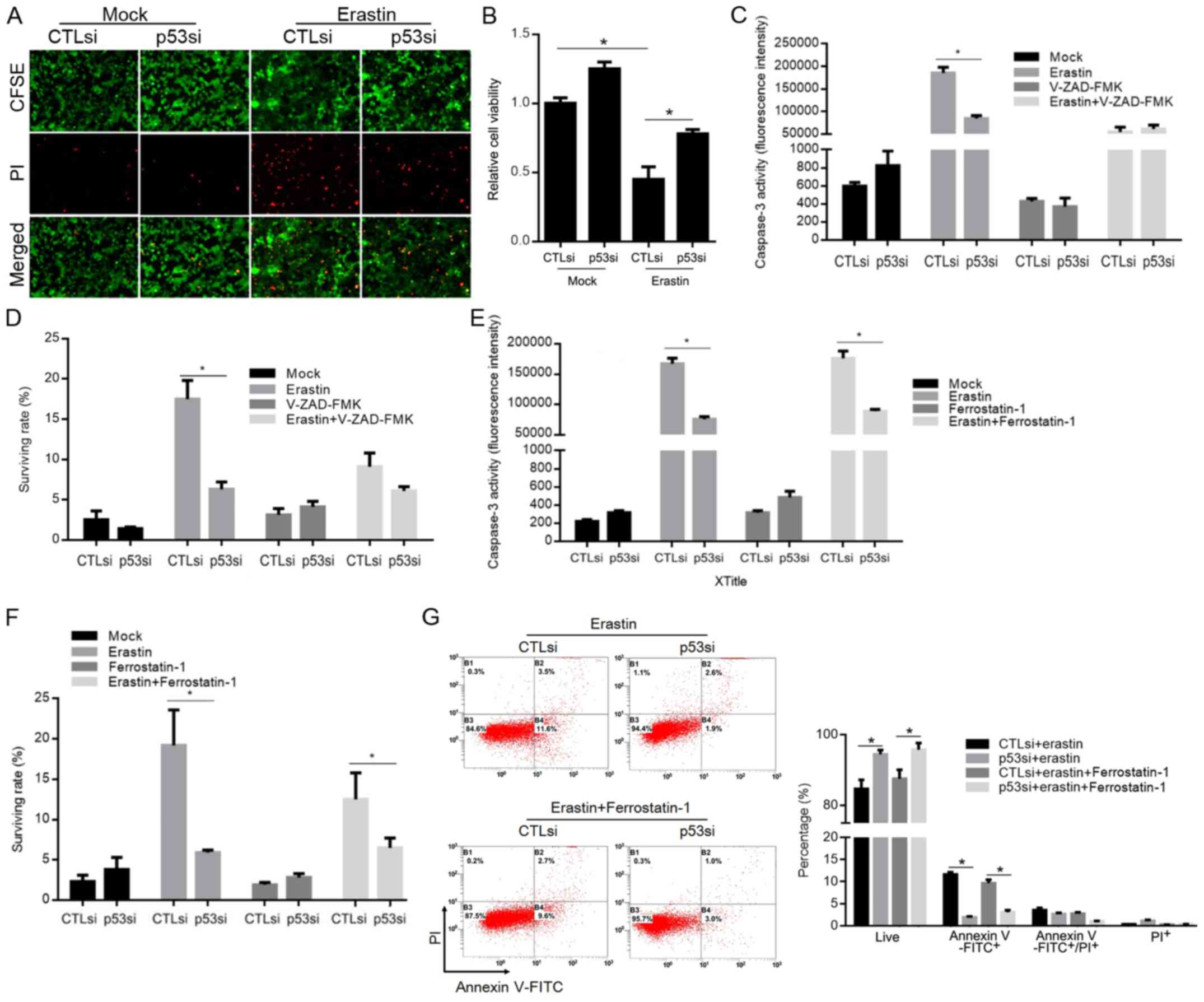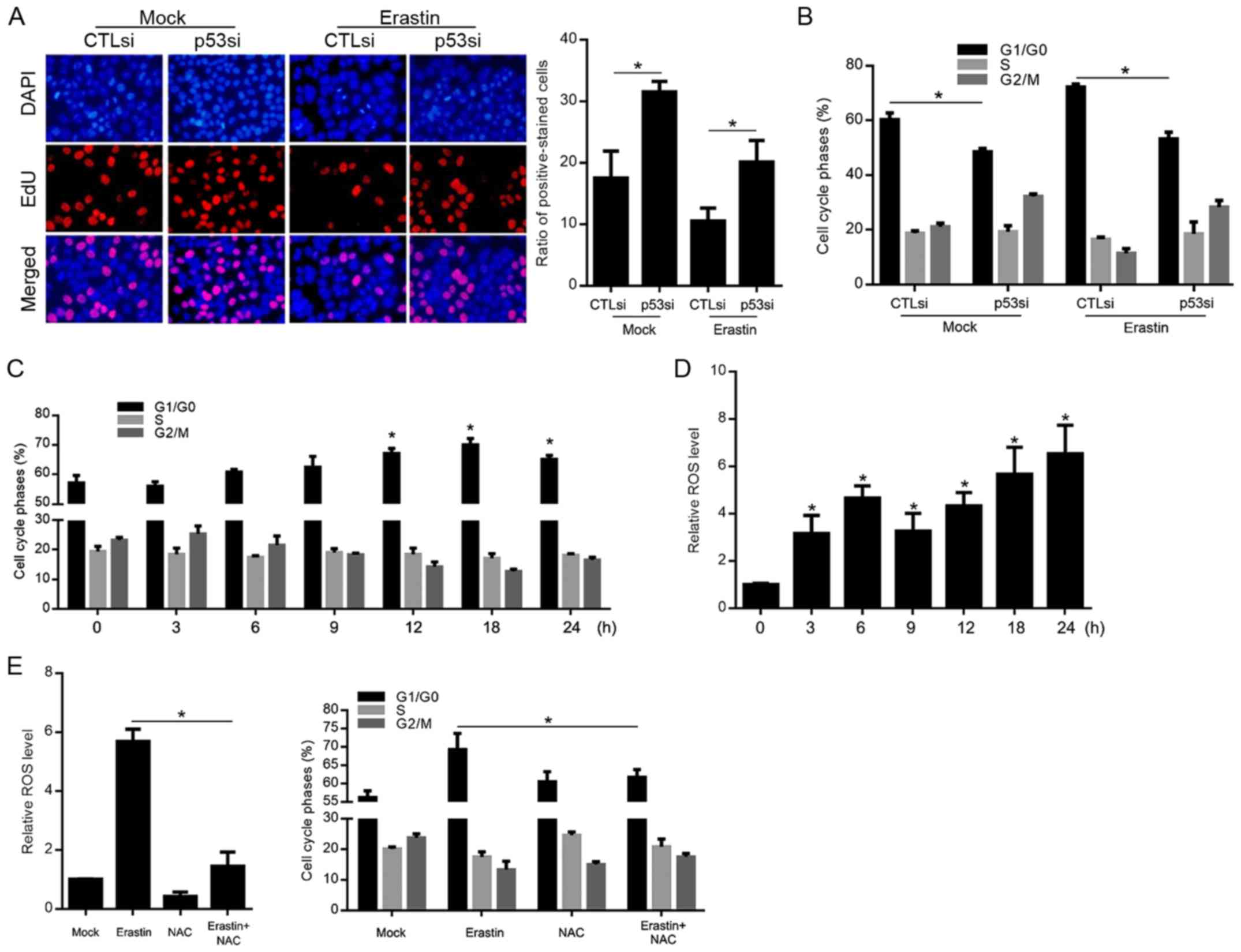|
1
|
Yagoda N, von Rechenberg M, Zaganjor E,
Bauer AJ, Yang WS, Fridman D, Wolpaw AJ, Smukste I, Peltier JM,
Boniface JJ, et al: RAS-RAF-MEK-dependent oxidative cell death
involving voltage-dependent anion channels. Nature. 447:864–868.
2007. View Article : Google Scholar : PubMed/NCBI
|
|
2
|
Dolma S, Lessnick SL, Hahn WC and
Stockwell BR: Identification of genotype-selective antitumor agents
using synthetic lethal chemical screening in engineered human tumor
cells. Cancer Cell. 3:285–296. 2003. View Article : Google Scholar : PubMed/NCBI
|
|
3
|
Dixon SJ, Lemberg KM, Lamprecht MR, Skouta
R, Zaitsev EM, Gleason CE, Patel DN, Bauer AJ, Cantley AM, Yang WS,
et al: Ferroptosis: An iron-dependent form of non-apoptotic cell
death. Cell. 149:1060–1072. 2012. View Article : Google Scholar : PubMed/NCBI
|
|
4
|
Huo H, Zhou Z, Qin J, Liu W, Wang B and Gu
Y: Erastin Disrupts mitochondrial permeability transition pore
(mPTP) and induces apoptotic death of colorectal cancer cells. PLoS
One. 11:e01546052016. View Article : Google Scholar : PubMed/NCBI
|
|
5
|
Vogelstein B, Lane D and Levine AJ:
Surfing the p53 network. Nature. 408:307–310. 2000. View Article : Google Scholar : PubMed/NCBI
|
|
6
|
Jiang L, Kon N, Li T, Wang SJ, Su T,
Hibshoosh H, Baer R and Gu W: Ferroptosis as a p53-mediated
activity during tumour suppression. Nature. 520:57–62. 2015.
View Article : Google Scholar : PubMed/NCBI
|
|
7
|
Gao M, Monian P, Quadri N, Ramasamy R and
Jiang X: Glutaminolysis and transferrin regulate ferroptosis. Mol
Cell. 59:298–308. 2015. View Article : Google Scholar : PubMed/NCBI
|
|
8
|
Tsai MH, Liu JF, Chiang YC, Hu SC, Hsu LF,
Lin YC, Lin ZC, Lee HC, Chen MC, Huang CL and Lee CW: Artocarpin,
an isoprenyl flavonoid, induces p53-dependent or independent
apoptosis via ROS-mediated MAPKs and Akt activation in non-small
cell lung cancer cells. Oncotarget. 8:28342–28358. 2017. View Article : Google Scholar : PubMed/NCBI
|
|
9
|
Zhou Z, Yin Y, Chang Q, Sun G, Lin J and
Dai Y: Downregulation of B-myb promotes senescence via the
ROS-mediated p53/p21 pathway, in vascular endothelial cells. Cell
Prolif. 50:2017. View Article : Google Scholar
|
|
10
|
Assaily W, Rubinger DA, Wheaton K, Lin Y,
Ma W, Xuan W, Brown-Endres L, Tsuchihara K, Mak TW and Benchimol S:
ROS-mediated p53 induction of Lpin1 regulates fatty acid oxidation
in response to nutritional stress. Mol Cell. 44:491–501. 2011.
View Article : Google Scholar : PubMed/NCBI
|
|
11
|
Seo SU, Cho HK, Min KJ, Woo SM, Kim S,
Park JW, Kim SH, Choi YH, Keum YS, Hyun JW, et al: Thioridazine
enhances sensitivity to carboplatin in human head and neck cancer
cells through downregulation of c-FLIP and Mcl-1 expression. Cell
Death Dis. 8:e25992017. View Article : Google Scholar : PubMed/NCBI
|
|
12
|
Wang SJ, Li D, Ou Y, Jiang L, Chen Y, Zhao
Y and Gu W: Acetylation is crucial for p53-mediated ferroptosis and
tumor suppression. Cell Rep. 17:366–373. 2016. View Article : Google Scholar : PubMed/NCBI
|
|
13
|
Shi Y, Nikulenkov F, Zawacka-Pankau J, Li
H, Gabdoulline R, Xu J, Eriksson S, Hedström E, Issaeva N, Kel A,
et al: ROS-dependent activation of JNK converts p53 into an
efficient inhibitor of oncogenes leading to robust apoptosis. Cell
Death Differ. 21:612–623. 2014. View Article : Google Scholar : PubMed/NCBI
|
|
14
|
Yang J, Zhao X, Tang M, Li L, Lei Y, Cheng
P, Guo W, Zheng Y, Wang W, Luo N, et al: The role of ROS and
subsequent DNA-damage response in PUMA-induced apoptosis of ovarian
cancer cells. Oncotarget. 8:23492–23506. 2017.PubMed/NCBI
|
|
15
|
An JJ, Shi KJ, Wei W, Hua FY, Ci YL, Jiang
Q, Li F, Wu P, Hui KY, Yang Y and Xu CM: The ROS/JNK/ATF2 pathway
mediates selenite-induced leukemia NB4 cell cycle arrest and
apoptosis in vitro and in vivo. Cell Death Dis. 4:e9732013.
View Article : Google Scholar : PubMed/NCBI
|
|
16
|
Suh DH, Kim MK, Kim HS, Chung HH and Song
YS: Mitochondrial permeability transition pore as a selective
target for anti-cancer therapy. Front Oncol. 3:412013. View Article : Google Scholar : PubMed/NCBI
|
|
17
|
Yamaguchi H, Hsu JL, Chen CT, Wang YN, Hsu
MC, Chang SS, Du Y, Ko HW, Herbst R and Hung MC:
Caspase-independent cell death is involved in the negative effect
of EGFR inhibitors on cisplatin in non-small cell lung cancer
cells. Clin Cancer Res. 19:845–854. 2013. View Article : Google Scholar : PubMed/NCBI
|
|
18
|
Aresvik DM, Pettersen RD, Abrahamsen TG
and Wright MS: 5-Fluorouracil-induced death of Jurkat T-cells-A
role for caspases and MCL-1. Anticancer Res. 30:3879–3887.
2010.PubMed/NCBI
|
|
19
|
Siskind LJ: Mitochondrial ceramide and the
induction of apoptosis. J Bioenerg Biomembr. 37:143–153. 2005.
View Article : Google Scholar : PubMed/NCBI
|
|
20
|
Colombini M: Ceramide channels and their
role in mitochondria-mediated apoptosis. Biochim Biophys Acta.
1797:1239–1244. 2010. View Article : Google Scholar : PubMed/NCBI
|
|
21
|
Lago CU, Sung HJ, Ma W, Wang PY and Hwang
PM: p53, Aerobic metabolism, and cancer. Antioxid Redox Signal.
15:1739–1748. 2011. View Article : Google Scholar : PubMed/NCBI
|
|
22
|
Downs I, Liu J, Aw TY, Adegboyega PA and
Ajuebor MN: The ROS scavenger, NAC, regulates hepatic Vα14iNKT
cells signaling during Fas mAb-dependent fulminant liver failure.
PLoS One. 7:e380512012. View Article : Google Scholar : PubMed/NCBI
|
|
23
|
Jürgensmeier JM, Xie Z, Deveraux Q,
Ellerby L, Bredesen D and Reed JC: Bax directly induces release of
cytochrome c from isolated mitochondria. Proc Natl Acad Sci
USA. 95:4997–5002. 1998. View Article : Google Scholar : PubMed/NCBI
|
|
24
|
Horn HF and Vousden KH: Coping with
stress: Multiple ways to activate p53. Oncogene. 26:1306–1316.
2007. View Article : Google Scholar : PubMed/NCBI
|
|
25
|
Zhang F, Wang W, Tsuji Y, Torti SV and
Torti FM: Post-transcriptional modulation of iron homeostasis
during p53-dependent growth arrest. J Biol Chem. 283:33911–33918.
2008. View Article : Google Scholar : PubMed/NCBI
|



















